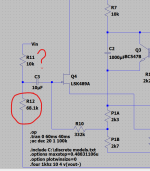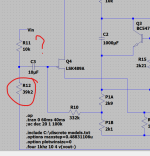hi,
question: I got two ACA 1.6 amps. One with power switch in front and a stereo/mono switch in back (amp1). The other has the power switch in back and no stereo/mono switch (amp2), it's just wired for stereo.
I want to use the two amps as monoblocks, each amp powering one speaker. When connecting the cables like in the build guide, I noticed less power coming out of the amp with no stereo/mono switch. Am I correct that this has to do with amp2 only using one channel for amplification, not both? And, would a solution be to use XLR outs as those seem to be wired to both channels on amp1 and amp2? Or would there be another solution that's practical.
Thanks in advance for any advice!
Martin
question: I got two ACA 1.6 amps. One with power switch in front and a stereo/mono switch in back (amp1). The other has the power switch in back and no stereo/mono switch (amp2), it's just wired for stereo.
I want to use the two amps as monoblocks, each amp powering one speaker. When connecting the cables like in the build guide, I noticed less power coming out of the amp with no stereo/mono switch. Am I correct that this has to do with amp2 only using one channel for amplification, not both? And, would a solution be to use XLR outs as those seem to be wired to both channels on amp1 and amp2? Or would there be another solution that's practical.
Thanks in advance for any advice!
Martin
As I recall there is one significant difference between some versions and you should check this...
Make sure both amps use the same value resistors here. I think the 10k was the same on any version but the feedback resistors varied:


There is a lot of confusion over the switch wiring and operation going off the ACA threads.
To run them as a monoblock you are effectively paralleling the outputs and feeding the same input to both. You get the same voltage output but the current delivery available into difficult loads is doubled.
You can also run them as bridged where one channel output feeds the input of the second channel. This gives twice the voltage swing into a load due to phase inversion of channel but with only the same current delivery. If your load is difficult this is not a good option.
Make sure both amps use the same value resistors here. I think the 10k was the same on any version but the feedback resistors varied:


There is a lot of confusion over the switch wiring and operation going off the ACA threads.
To run them as a monoblock you are effectively paralleling the outputs and feeding the same input to both. You get the same voltage output but the current delivery available into difficult loads is doubled.
You can also run them as bridged where one channel output feeds the input of the second channel. This gives twice the voltage swing into a load due to phase inversion of channel but with only the same current delivery. If your load is difficult this is not a good option.
From what I can tell, they use the same resistors. I've attached the diagrams for how the two amps are wired, labeled as amp1 and amp2. amp2 is the one which gives me less power. My question would really be: would using the XLR out on both amps get me equal power on both channels when connected like in Step 54 of the build guide --> https://guides.diyaudio.com/Guide/Amp+Camp+Amp+V1.6+Build+Guide/5#s124
Attachments
Just going off the diagrams... and this is my best guess as to what you are doing. Its not easy without being there and seeing how you have it all configured 🙂
Amp 2 has the 39k and the switch. The input is fed into the left channel and the switch couples the output of the left channel into the input of the right channel via the resistor. This gives you twice the voltage swing between the two negative speaker terminals compared to a single amp or a single stereo amp running in parallel.
So for example 4 volts rms out from a standard channel gives 2 watts rms into 8 ohms. The bridged output is 8 volts rms (as one channels output voltage goes positive the other channels goes negative by the same amount). So 8 volts rms into 8 ohm is 8 watts rms. So this configuration sounds 'louder'.
Amp 1 has no means to do this (no switch to couple output to input) and so if you try and connect the amp in the same way with the speaker between the two negative terminals only only one channel is driven. You get 4 volts rms out from that channel but the other channel has no signal present and acts simply as a ground. So you only get the 2 watts output from this one.
To make them the same you would have to add the 39k to this amp and wire it as if the switch were present and closed.
Amp 2 has the 39k and the switch. The input is fed into the left channel and the switch couples the output of the left channel into the input of the right channel via the resistor. This gives you twice the voltage swing between the two negative speaker terminals compared to a single amp or a single stereo amp running in parallel.
So for example 4 volts rms out from a standard channel gives 2 watts rms into 8 ohms. The bridged output is 8 volts rms (as one channels output voltage goes positive the other channels goes negative by the same amount). So 8 volts rms into 8 ohm is 8 watts rms. So this configuration sounds 'louder'.
Amp 1 has no means to do this (no switch to couple output to input) and so if you try and connect the amp in the same way with the speaker between the two negative terminals only only one channel is driven. You get 4 volts rms out from that channel but the other channel has no signal present and acts simply as a ground. So you only get the 2 watts output from this one.
To make them the same you would have to add the 39k to this amp and wire it as if the switch were present and closed.
Please look at post 12084 in the ACA thread.
Link: https://www.diyaudio.com/community/threads/amp-camp-amp-aca.215392/page-605#post-7650215
39K is the wrong value to use to get the gain of the inverter side to be minus one when using single ended drive to get a balanced output. It does not take into account the 10K that is on the PCB.
Verify that R12 is 39K and not 68K like the original ACA.
Link: https://www.diyaudio.com/community/threads/amp-camp-amp-aca.215392/page-605#post-7650215
39K is the wrong value to use to get the gain of the inverter side to be minus one when using single ended drive to get a balanced output. It does not take into account the 10K that is on the PCB.
Verify that R12 is 39K and not 68K like the original ACA.